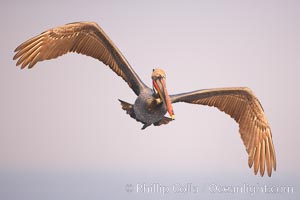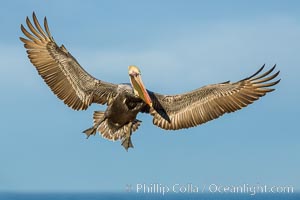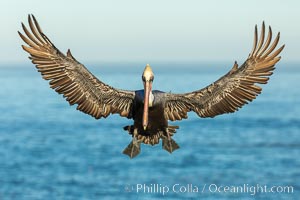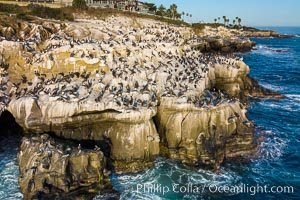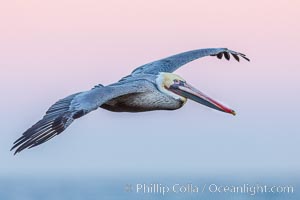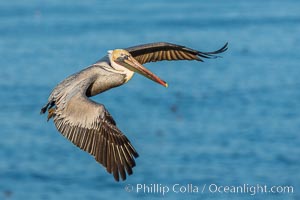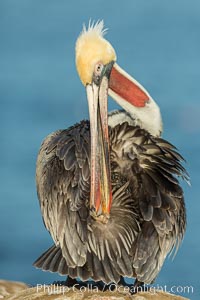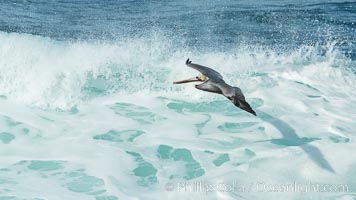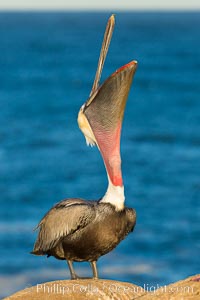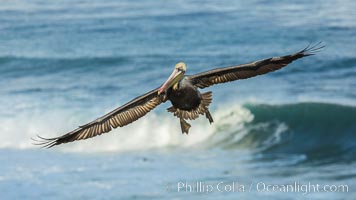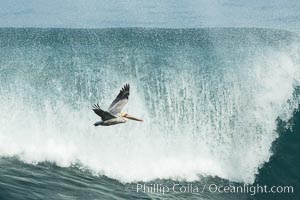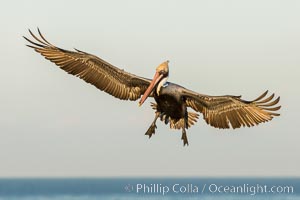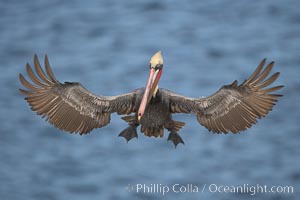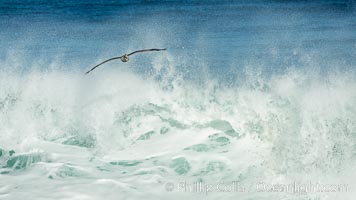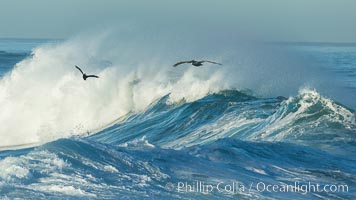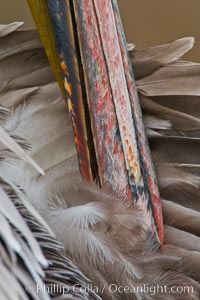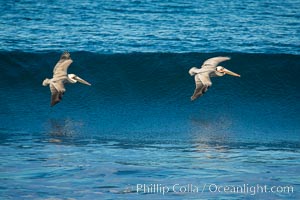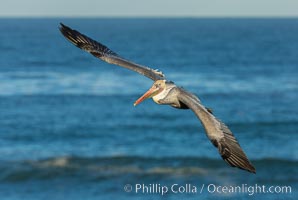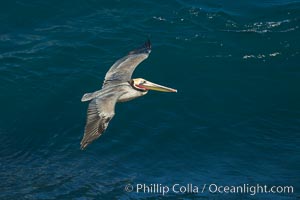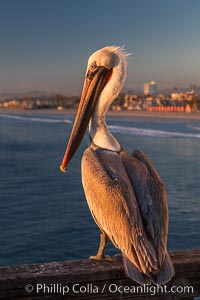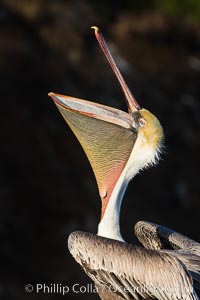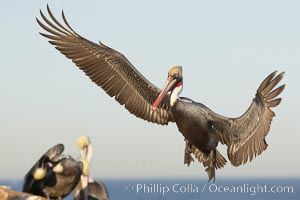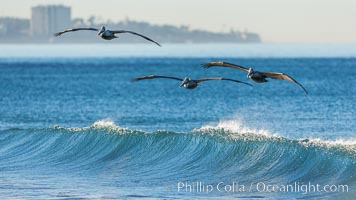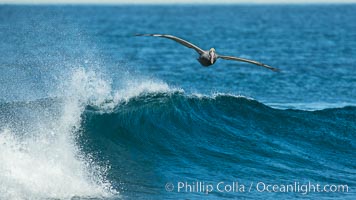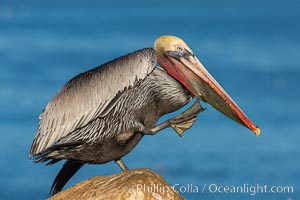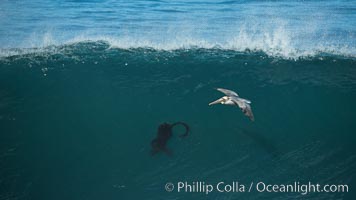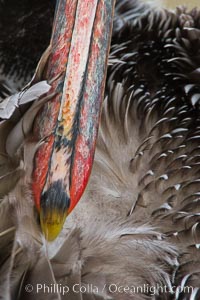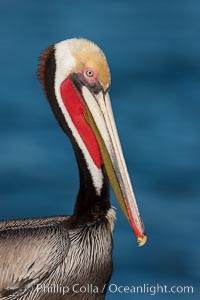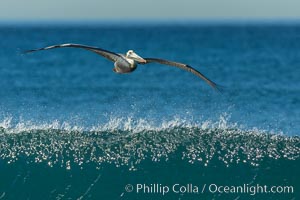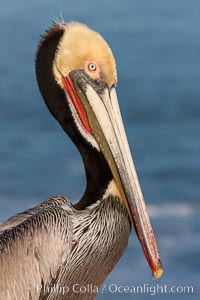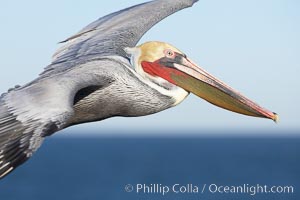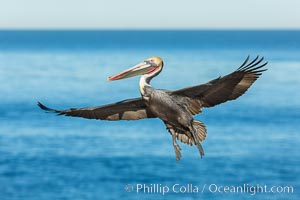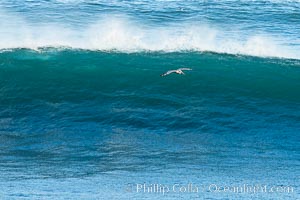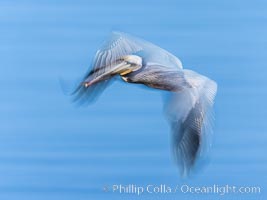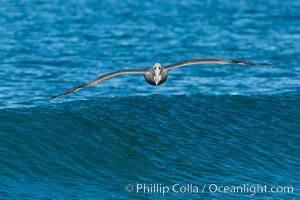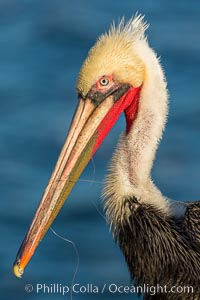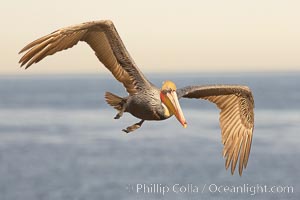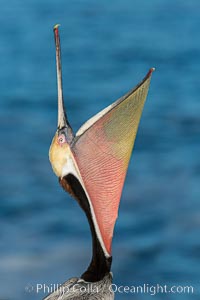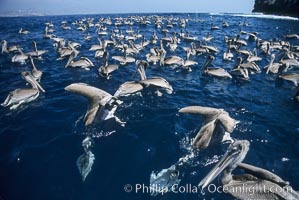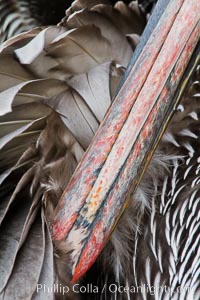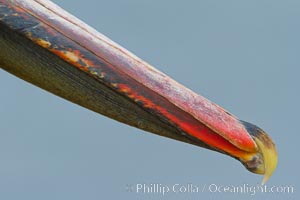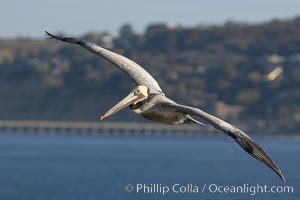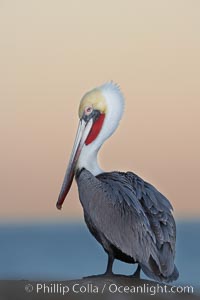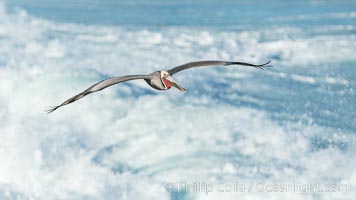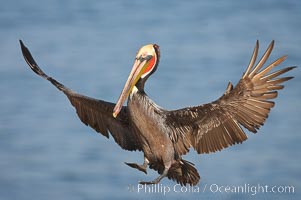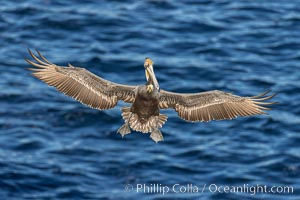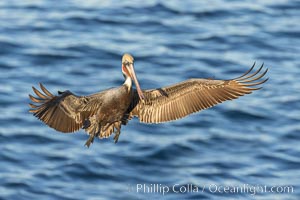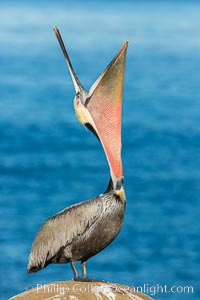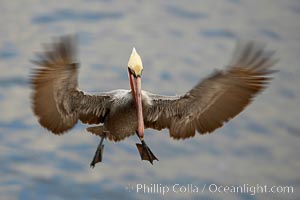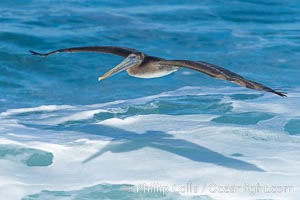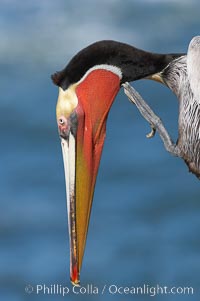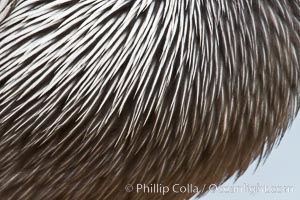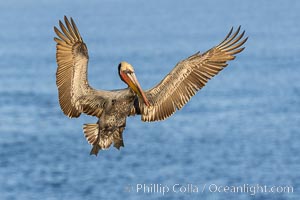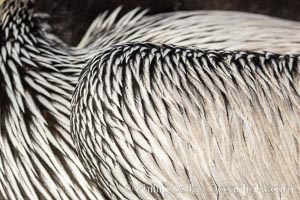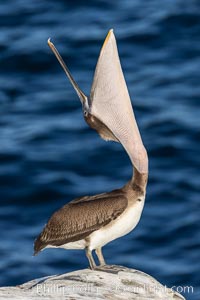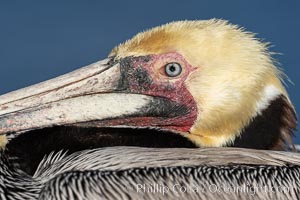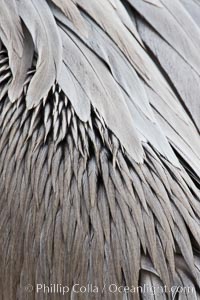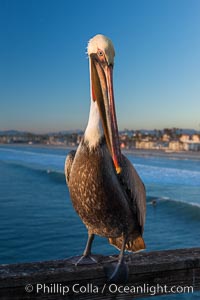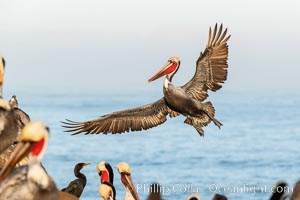
California brown pelican in flight, spreading wings wide to slow in anticipation of landing on seacliffs. Note the classic winter breeding plumage, with bright red throat, yellow and white head and neck, and brown hind neck.
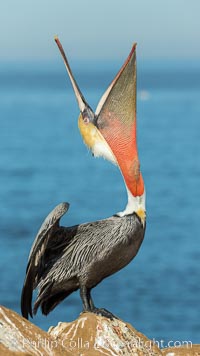
California Brown Pelican head throw, stretching its throat to keep it flexible and healthy. Note the winter mating plumage, olive and red throat, yellow head.
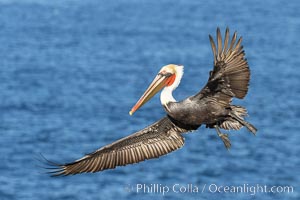
California brown pelican in flight, spreading wings wide to slow in anticipation of landing on seacliffs
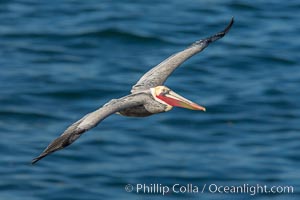
Brown pelican in flight. The wingspan of the brown pelican is over 7 feet wide. The California race of the brown pelican holds endangered species status. In winter months, breeding adults assume a dramatic plumage.
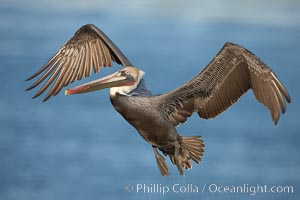
Brown pelican in flight. The wingspan of the brown pelican is over 7 feet wide. The California race of the brown pelican holds endangered species status. In winter months, breeding adults assume a dramatic plumage.
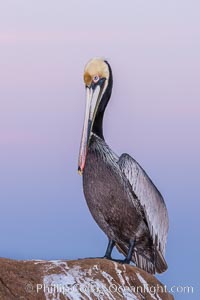
California brown pelican, portrait in pink-purple predawn light, rests on sandstone seabluff. The characteristic mating plumage of the California race of brown pelican is shown, with red gular throat pouch and dark brown hindneck colors.
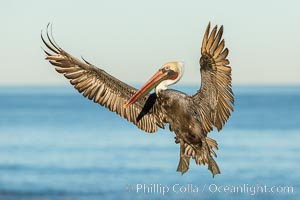
Brown pelican in flight. The wingspan of the brown pelican is over 7 feet wide. The California race of the brown pelican holds endangered species status. In winter months, breeding adults assume a dramatic plumage
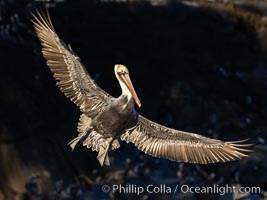
California brown pelican in flight, spreading wings wide to slow in anticipation of landing on seacliffs
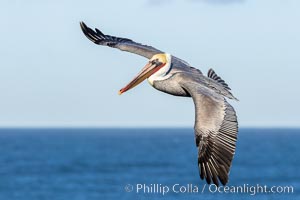
California Brown pelican in flight, soaring along sea cliffs above the ocean in La Jolla, California. The wingspan of the brown pelican is over 7 feet wide. The California race of the brown pelican holds endangered species status.
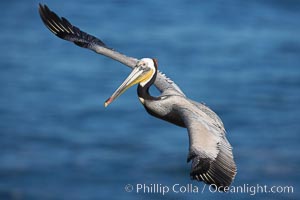
Brown pelican in flight. The wingspan of the brown pelican is over 7 feet wide. The California race of the brown pelican holds endangered species status. In winter months, breeding adults assume a dramatic plumage.
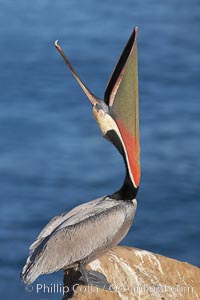
Brown pelican head throw. During a bill throw, the pelican arches its neck back, lifting its large bill upward and stretching its throat pouch.
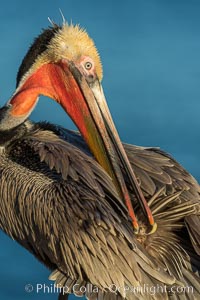
A brown pelican preening, reaching with its beak to the uropygial gland (preen gland) near the base of its tail. Preen oil from the uropygial gland is spread by the pelican's beak and back of its head to all other feathers on the pelican, helping to keep them water resistant and dry.
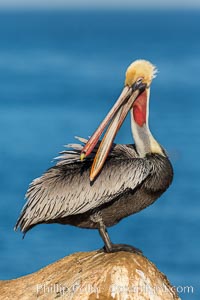
Brown pelican portrait, displaying winter plumage with distinctive yellow head feathers and red gular throat pouch.
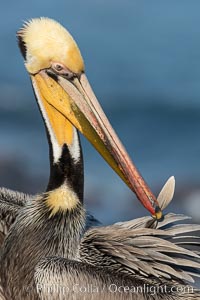
Yellow morph California brown pelican preening, cleaning its feathers after foraging on the ocean, with distinctive winter breeding plumage with distinctive dark brown nape, yellow head feathers. Note the unusual yellow gular throat pouch.
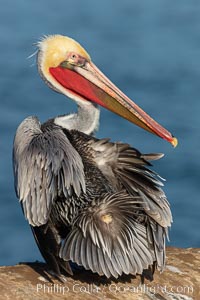
A brown pelican preening, uropygial gland (preen gland) visible near the base of its tail. Preen oil from the uropygial gland is spread by the pelican's beak and back of its head to all other feathers on the pelican, helping to keep them water resistant and dry. Note adult winter breeding plumage in display, with brown neck, red gular throat pouch and yellow and white head.
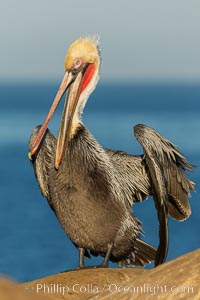
Brown pelican portrait, displaying winter plumage with distinctive yellow head feathers and red gular throat pouch
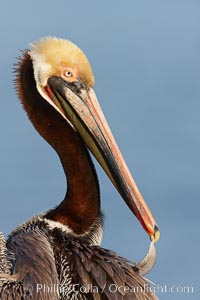
Brown pelican preening, cleaning its feathers after foraging on the ocean, with distinctive winter breeding plumage with distinctive dark brown nape, yellow head feathers and red gular throat pouch.
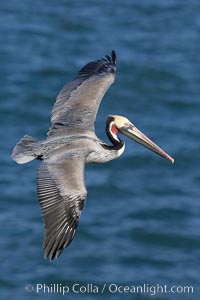
California brown pelican in flight, soaring over the ocean with its huge wings outstretched. Adult winter breeding plumage. The wingspan of the brown pelican can be over 7 feet wide. The California race of the brown pelican holds endangered species status. Adult winter breeding plumage showing brown hindneck and red gular throat pouch.
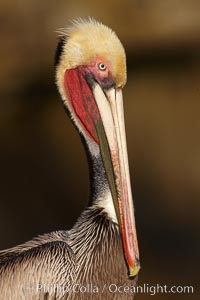
Brown pelican portrait, displaying winter breeding plumage with distinctive dark brown nape, yellow head feathers and red gular throat pouch.
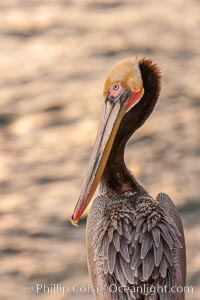
Brown pelican, golden sunrise light, winter adult breeding plumage, showing bright red gular pouch and dark brown hindneck plumage of breeding adults. This large seabird has a wingspan over 7 feet wide. The California race of the brown pelican holds endangered species status, due largely to predation in the early 1900s and to decades of poor reproduction caused by DDT poisoning
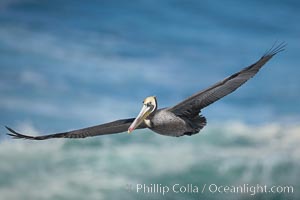
Brown pelican in flight. The wingspan of the brown pelican is over 7 feet wide. The California race of the brown pelican holds endangered species status. In winter months, breeding adults assume a dramatic plumage.
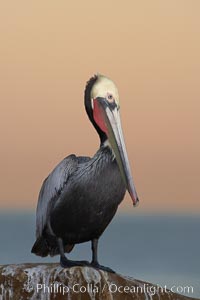
Brown pelican, winter adult breeding plumage, showing bright red gular pouch and dark brown hindneck plumage of breeding adults. This large seabird has a wingspan over 7 feet wide. The California race of the brown pelican holds endangered species status, due largely to predation in the early 1900s and to decades of poor reproduction caused by DDT poisoning.
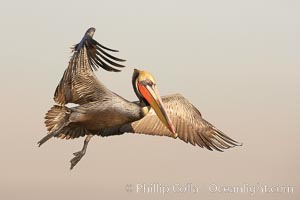
Brown pelican in flight. The wingspan of the brown pelican is over 7 feet wide. The California race of the brown pelican holds endangered species status. In winter months, breeding adults assume a dramatic plumage.
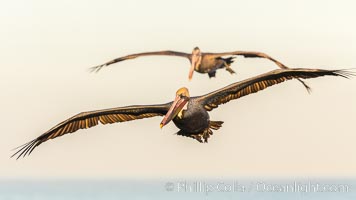
Brown pelican in flight. The wingspan of the brown pelican is over 7 feet wide. The California race of the brown pelican holds endangered species status. In winter months, breeding adults assume a dramatic plumage.
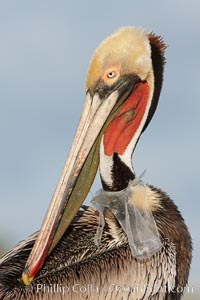
A California brown pelican entangled in a plastic bag which is wrapped around its neck. This unfortunate pelican probably became entangled in the bag by mistaking the floating plastic for food and diving on it, spearing it in such a way that the bag has lodged around the pelican's neck. Plastic bags kill and injure untold numbers of marine animals each year.
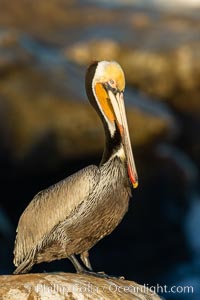
Brown pelican portrait, displaying winter plumage with distinctive yellow head feathers and colorful gular throat pouch
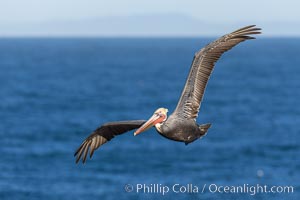
California Brown pelican in flight, soaring along sea cliffs above the ocean in La Jolla, California. The wingspan of the brown pelican is over 7 feet wide. The California race of the brown pelican holds endangered species status.
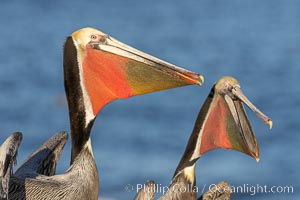
Brown pelicans jousting, with bright red throat, yellow and white head and brown hind neck, winter plumage.
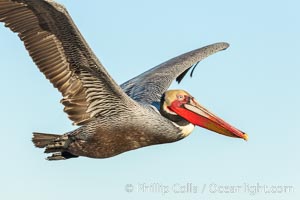
California brown pelican in flight, spreading wings wide to slow in anticipation of landing on seacliffs
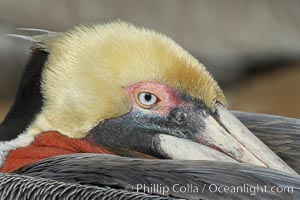
Brown pelican closeup showing characteristic winter mating plumage, including yellow head, dark brown nape of neck and red gular throat pouch.
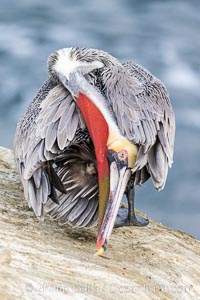
A California brown pelican preening, rubbing the back of its head and neck on the uropygial gland (preen gland) near the base of its tail. Preen oil from the uropygial gland is spread by the pelican's beak and back of its head to all other feathers on the pelican, helping to keep them water resistant and dry. Adult winter breeding plumage showing white hindneck and red gular throat pouch
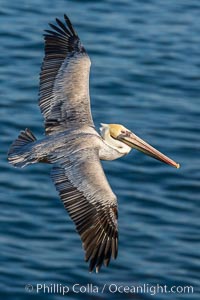
Brown pelican in flight. The wingspan of the brown pelican is over 7 feet wide. The California race of the brown pelican holds endangered species status. In winter months, breeding adults assume a dramatic plumage
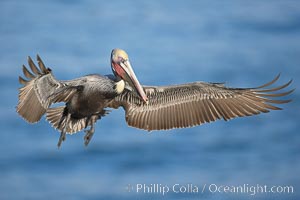
Brown pelican in flight, spreading its wings wide to slow before landing on cliffs overlooking the ocean. The wingspan of the brown pelican is over 7 feet wide. The California race of the brown pelican holds endangered species status.
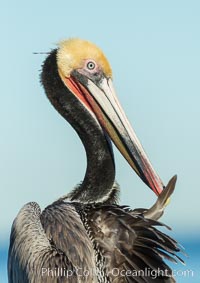
Brown pelican preening, cleaning its feathers after foraging on the ocean, with distinctive winter breeding plumage with distinctive dark brown nape, yellow head feathers and red gular throat pouch
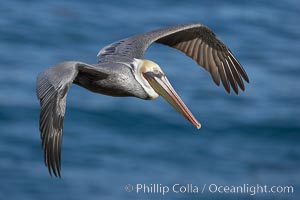
California brown pelican in flight, soaring over the ocean with its huge wings outstretched. The wingspan of the brown pelican can be over 7 feet wide. The California race of the brown pelican holds endangered species status.
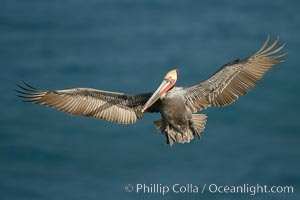
Brown pelican in flight, spreading its wings wide to slow before landing on cliffs overlooking the ocean. The wingspan of the brown pelican is over 7 feet wide. The California race of the brown pelican holds endangered species status.
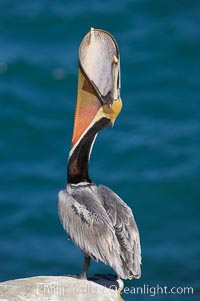
Brown pelican head throw. During a bill throw, the pelican arches its neck back, lifting its large bill upward and stretching its throat pouch.
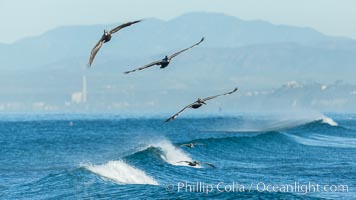
California Brown Pelicans flying on a wave, riding the updraft from the wave. Encinitas and Carlsbad coastline in the background.
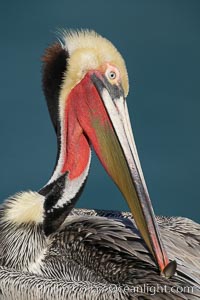
Brown pelican portrait, displaying winter breeding plumage with distinctive dark brown nape, yellow head feathers and red gular throat pouch.
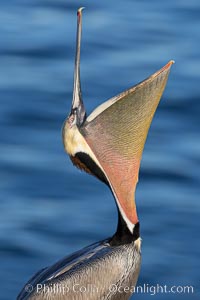
California Brown pelican performing a head throw, with breeding plumage including distinctive yellow and white head feathers, red gular throat pouch, brown hind neck and greyish body.
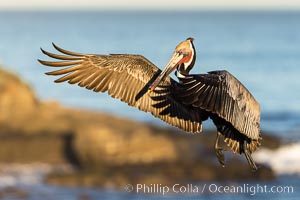
California brown pelican in flight, spreading wings wide to slow in anticipation of landing on seacliffs
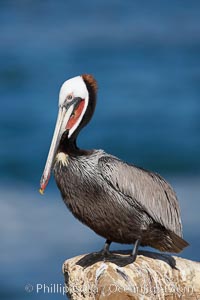
Brown pelican. This large seabird has a wingspan over 7 feet wide. The California race of the brown pelican holds endangered species status, due largely to predation in the early 1900s and to decades of poor reproduction caused by DDT poisoning. In winter months, breeding adults assume a dramatic plumage with brown neck, yellow and white head and bright red gular throat pouch.
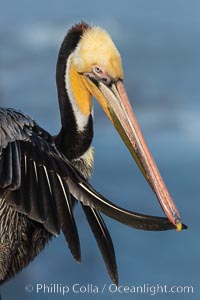
Brown pelican preening, cleaning its feathers after foraging on the ocean, with distinctive winter breeding plumage with distinctive dark brown nape, yellow head feathers, although this one displays a yellow (rather than the usual red) gular throat pouch.
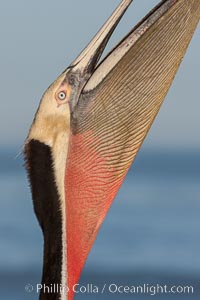
Brown pelican stretches its neck, to keep its throat pouch limber. The characteristic winter mating plumage of the California race of brown pelican is shown, with deep red gular throat, yellow head and dark brown hindneck.
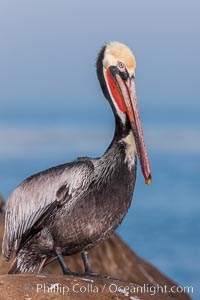
Brown pelican, winter adult breeding plumage, showing bright red gular pouch and dark brown hindneck plumage of breeding adults. This large seabird has a wingspan over 7 feet wide. The California race of the brown pelican holds endangered species status, due largely to predation in the early 1900s and to decades of poor reproduction caused by DDT poisoning
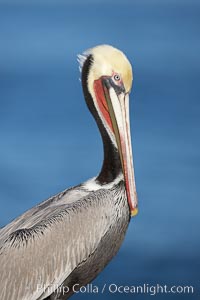
Brown pelican, winter plumage, showing bright red gular pouch and dark brown hindneck colors of breeding adults. This large seabird has a wingspan over 7 feet wide. The California race of the brown pelican holds endangered species status, due largely to predation in the early 1900s and to decades of poor reproduction caused by DDT poisoning.
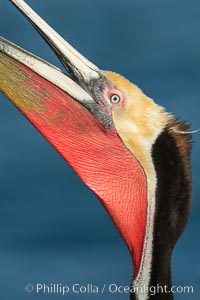
California Brown Pelican head throw, stretching its throat to keep it flexible and healthy. Note the winter mating plumage, olive and red throat, yellow head.
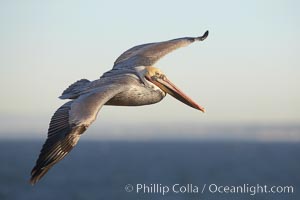
California brown pelican in flight, soaring over the ocean with its huge wings outstretched. The wingspan of the brown pelican can be over 7 feet wide. The California race of the brown pelican holds endangered species status. Adult winter non-breeding plumage showing white hindneck and red gular throat pouch.
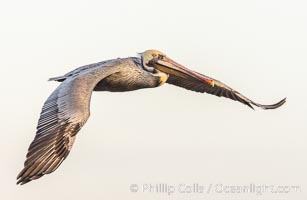
California Brown pelican in flight, captured beautifully as it soars over cliffs and the ocean in La Jolla, California.
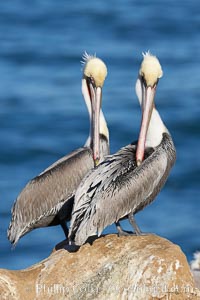
Brown pelicans preening. After wiping its long beak on the uropygial gland near the base of its tail, the pelican spreads the preen oil on feathers about its body, helping to keep them water resistant, an important protection for a bird that spends much of its life diving in the ocean for prey.
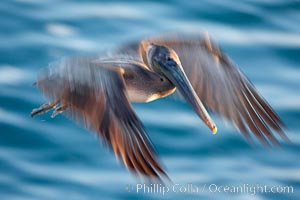
Brown pelican in flight. The wingspan of the brown pelican is over 7 feet wide. Long exposure shows motion as a blur. The California race of the brown pelican holds endangered species status. In winter months, breeding adults assume a dramatic plumage with dark brown hindneck and bright red gular throat pouch.
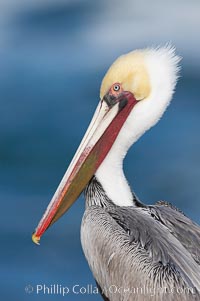
Brown pelican, adult winter non-breeding plumage showing white hindneck and red gular throat pouch.. This large seabird has a wingspan over 7 feet wide. The California race of the brown pelican holds endangered species status, due largely to predation in the early 1900s and to decades of poor reproduction caused by DDT poisoning.
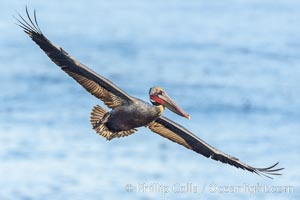
California Brown pelican in flight, wings spread as it soars over cliffs and the ocean in La Jolla, California.
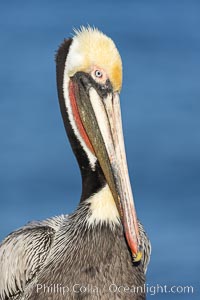
California brown pelican portrait with breeding plumage, note the striking red throat, yellow and white head
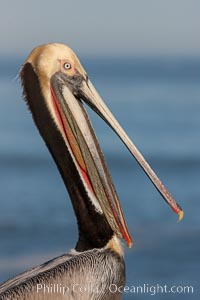
Portrait of California brown pelican, with the characteristic winter mating plumage shown: red throat, yellow head and dark brown hindneck.
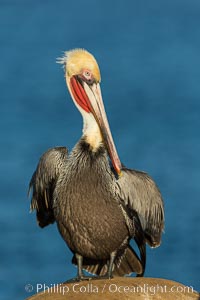
Brown pelican portrait, displaying winter plumage with distinctive yellow head feathers and red gular throat pouch
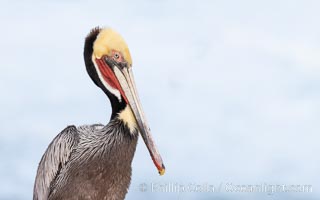
Contemplative brown pelican portrait on overcast day, with surf and foam in the background. Breeding plumage with yellow and white head, red throat, brown neck.
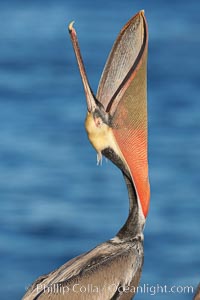
Brown pelican head throw. During a bill throw, the pelican arches its neck back, lifting its large bill upward and stretching its throat pouch.
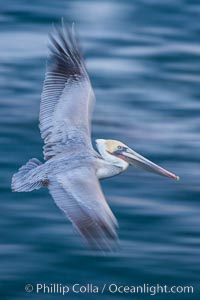
Brown pelican in flight. The wingspan of the brown pelican is over 7 feet wide. The California race of the brown pelican holds endangered species status. In winter months, breeding adults assume a dramatic plumage
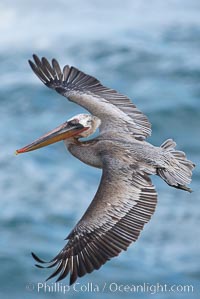
Brown pelican in flight. The wingspan of the brown pelican is over 7 feet wide. The California race of the brown pelican holds endangered species status. In winter months, breeding adults assume a dramatic plumage.
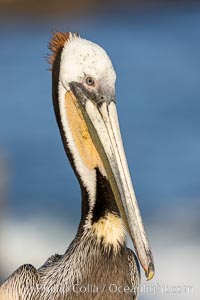
Yellow Morph California Brown Pelican Portrait, note the distinctive winter mating plumage but the unusual yellow throat
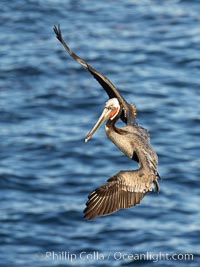
California Brown pelican in flight, soaring along sea cliffs above the ocean in La Jolla, California
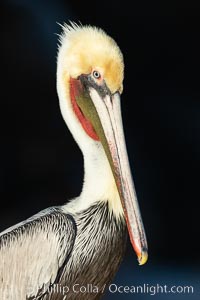
Brown pelican portrait, displaying winter plumage with distinctive yellow head feathers and colorful gular throat pouch
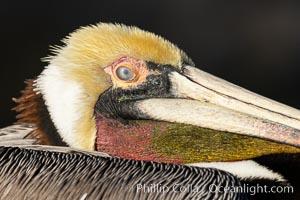
Brown pelican nictitating membrane, a translucent membrane that forms an inner eyelid in birds, reptiles, and some mammals. It can be drawn across the eye to protect it from dust and keep it moist.
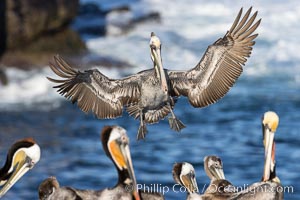
California brown pelican in flight, spreading wings wide to slow in anticipation of landing on seacliffs
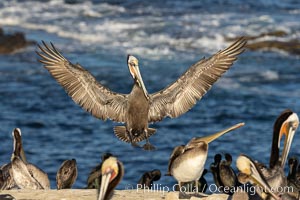
California brown pelican in flight, spreading wings wide to slow in anticipation of landing on seacliffs
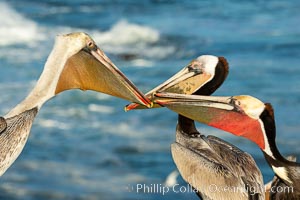
Three California brown pelicans mock jousting, displaying vividly-colored throat skin and mating plumage.
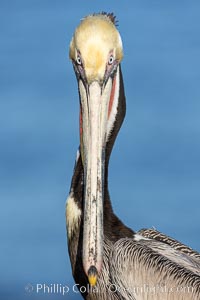
Brown pelican staring down the photographer. Portrait of California brown pelican, with the characteristic winter mating plumage shown: red throat, yellow head and dark brown hindneck
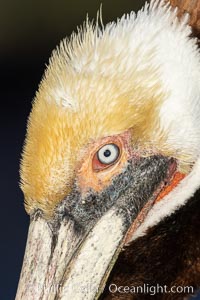
Brown pelican close up portrait, showing eye and transition from plumage to beak, with winter yellow and white head feathers.
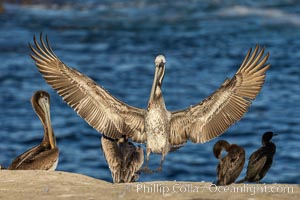
California brown pelican in flight, spreading wings wide to slow in anticipation of landing on seacliffs
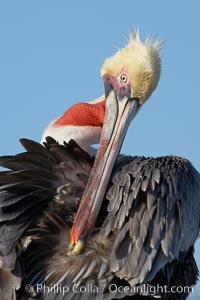
A brown pelican preening, reaching with its beak to the uropygial gland (preen gland) near the base of its tail. Preen oil from the uropygial gland is spread by the pelican's beak and back of its head to all other feathers on the pelican, helping to keep them water resistant and dry.
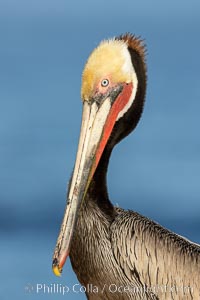
Portrait of California brown pelican, with the characteristic winter mating plumage shown: red throat, yellow head and dark brown hindneck
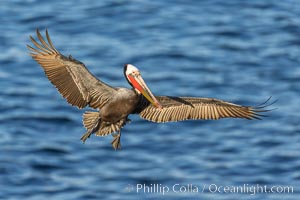
California brown pelican in flight, spreading wings wide to slow in anticipation of landing on seacliffs
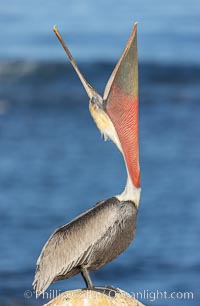
California Brown pelican performing a head throw, with breeding plumage including distinctive yellow and white head feathers, red gular throat pouch, brown hind neck and greyish body.
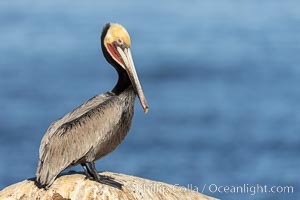
Portrait of California brown pelican, with the characteristic winter mating plumage shown: red throat, yellow head and dark brown hindneck
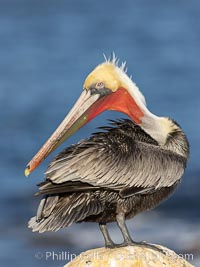
A brown pelican preening, reaching with its beak to the uropygial gland (preen gland) near the base of its tail. Preen oil from the uropygial gland is spread by the pelican's beak and back of its head to all other feathers on the pelican, helping to keep them water resistant and dry.
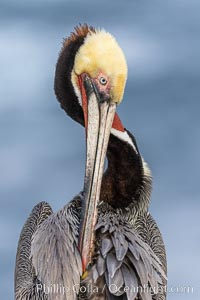
A brown pelican preening, reaching with its beak to the uropygial gland (preen gland) near the base of its tail. Preen oil from the uropygial gland is spread by the pelican's beak and back of its head to all other feathers on the pelican, helping to keep them water resistant and dry.
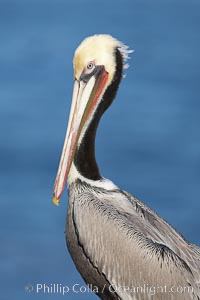
Brown pelican, winter plumage, showing bright red gular pouch and dark brown hindneck colors of breeding adults. This large seabird has a wingspan over 7 feet wide. The California race of the brown pelican holds endangered species status, due largely to predation in the early 1900s and to decades of poor reproduction caused by DDT poisoning.
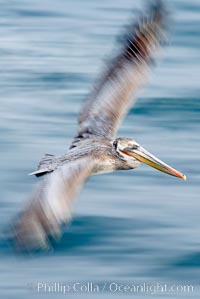
Brown pelican in flight. The wingspan of the brown pelican is over 7 feet wide. Long exposure shows motion as a blur. The California race of the brown pelican holds endangered species status. In winter months, breeding adults assume a dramatic plumage with dark brown hindneck and bright red gular throat pouch.
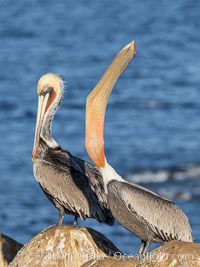
California Brown Pelican head throw, stretching its throat to keep it flexible and healthy. Note the winter mating plumage, olive and red throat, yellow head
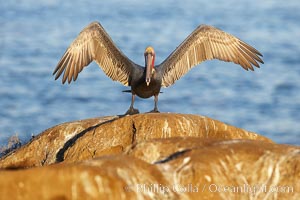
Brown pelican spreads its large wings as it balances on a perch above the ocean, early morning light, displaying adult winter plumage. This large seabird has a wingspan over 7 feet wide. The California race of the brown pelican holds endangered species status, due largely to predation in the early 1900s and to decades of poor reproduction caused by DDT poisoning.
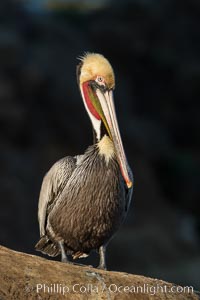
Brown pelican portrait, displaying winter breeding plumage with distinctive dark brown nape, yellow head feathers and red gular throat pouch
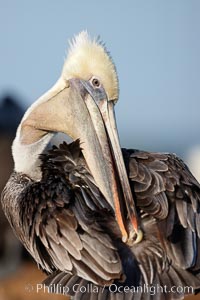
A brown pelican preening, reaching with its beak to the uropygial gland (preen gland) near the base of its tail. Preen oil from the uropygial gland is spread by the pelican's beak and back of its head to all other feathers on the pelican, helping to keep them water resistant and dry.
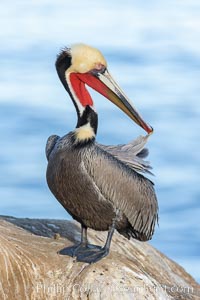
Brown pelican, winter adult breeding plumage, showing bright red gular pouch and dark brown hindneck plumage of breeding adults. This large seabird has a wingspan over 7 feet wide. The California race of the brown pelican holds endangered species status, due largely to predation in the early 1900s and to decades of poor reproduction caused by DDT poisoning

Ghostly California brown pelican glides over breaking surf, abstract with motion blur and pastel pre-dawn colors
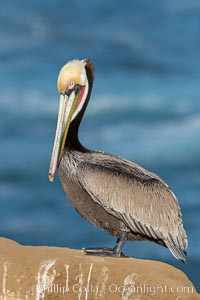
Brown pelican portrait, displaying winter breeding plumage with distinctive dark brown nape, yellow head feathers and red gular throat pouch
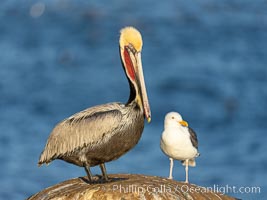
California brown pelican portrait with breeding plumage, note the striking red throat, yellow and white head
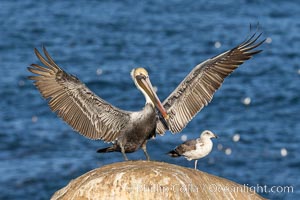
California Brown pelican in flight, captured beautifully as it lands on sea cliffs in La Jolla, California.
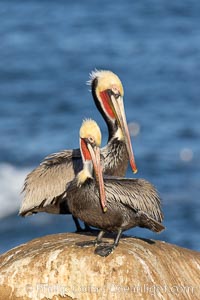
Portrait of two California brown pelicans with breeding plumage, note the striking red throat, yellow and white head
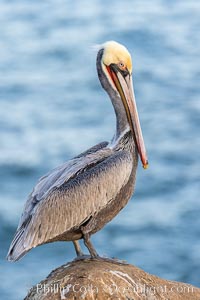
California brown pelican portrait with in-transition breeding plumage, note the striking red throat, yellow and white head
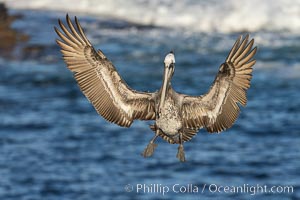
California brown pelican in flight, spreading wings wide to slow in anticipation of landing on seacliffs
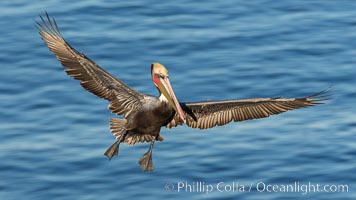
California brown pelican in flight. The wingspan of the brown pelican is over 7 feet wide. The California race of the brown pelican holds endangered species status. In winter months, breeding adults assume a dramatic plumage.
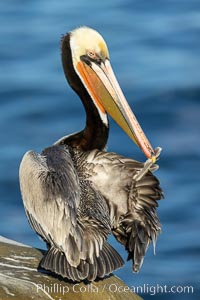
Brown pelican preening, cleaning its feathers after foraging on the ocean, with distinctive winter breeding plumage with distinctive dark brown nape, yellow head feathers and red gular throat pouch.
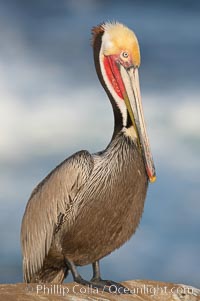
California brown pelican portrait, winter mating plumage, bright red gular pouch and dark brown hindneck.
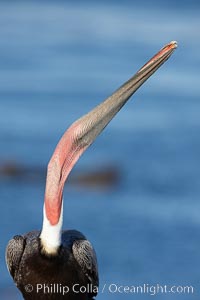
Brown pelican head throw. During a bill throw, the pelican arches its neck back, lifting its large bill upward and stretching its throat pouch.
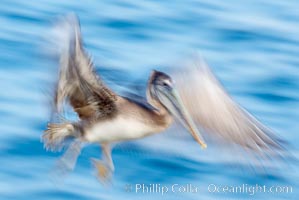
Brown pelican in flight. The wingspan of the brown pelican is over 7 feet wide. Long exposure shows motion as a blur. The California race of the brown pelican holds endangered species status. In winter months, breeding adults assume a dramatic plumage with dark brown hindneck and bright red gular throat pouch.
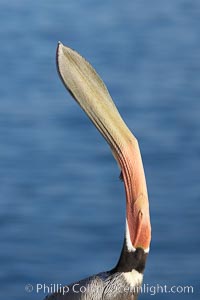
Brown pelican head throw. During a bill throw, the pelican arches its neck back, lifting its large bill upward and stretching its throat pouch.
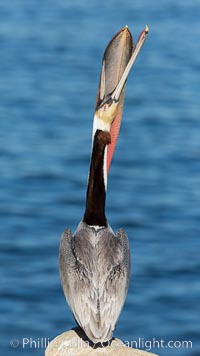
Brown pelican head throw. During a bill throw, the pelican arches its neck back, lifting its large bill upward and stretching its throat pouch
